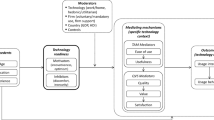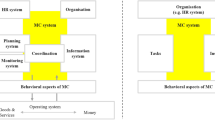Abstract
This article addresses the question how networks of practice (NoPs) can create value (operationalized as their contribution to individual members’ performance) for organizations through knowledge integration and management. The discussion focuses on two sets of variables influencing member performance: the embeddedness of the network and the use of different media. Three dimensions of embeddedness are distinguished: (1) embeddedness in practice: the extent to which the knowledge shared in the network is integrated in members’ (local) practices; (2) structural embeddedness: the extent to which network members are connected to each other and know who knows what; and (3) relational embeddedness: the extent to which the network is characterized by strong social ties. In terms of communication media, information and communication technology (ICT)-enabled and face-to-face interaction are distinguished. A survey study among 206 members of different NoPs reveals that all three forms of embeddedness are important antecedents of NoP member performance (explaining 43% of the variance in performance) and that these forms are interrelated. Furthermore, ICT use positively influences embeddedness in practice, whereas face-to-face communication contributes to the structural and relational embeddedness of an NoP. This contributes to knowledge management and ICT literature in general and NoP theory in particular.


Similar content being viewed by others
References
Agterberg, M., Van den Hooff, B., Huysman, M. and Soekijad, M. (2010). Keeping the Wheels Turning: The dynamics of managing networks of practice, Journal of Management Studies 47 (1): 85–108.
Bos, N., Olson, J., Gergle, D., Olson, G. and Wright, Z. (2002). Effects of Four Computer-mediated Communication Channels on Trust Development, in Proceedings of Conference on Human Factors in Computing Systems (CHI) 2002 (Minneapolis, MN, April 2002); New York: ACM Press, 135–140.
Brown, J.S. and Duguid, P. (1991). Organizational Learning and Communities-of-practice: Toward a unified view of working, learning and innovation, Organization Science 2: 40–57.
Brown, J.S. and Duguid, P. (2001). Knowledge and Organization: A social-practice perspective, Organization Science 12: 198–213.
Browne, M.W. and Cudeck, R. (1993). Alternative Ways of Assessing Model Fit, in K.A. Bollen and J.S. Long (eds.) Testing Structural Equation Models, Newbury Park, CA: Sage, pp. 136–162.
Burgoon, J.K., Stoner, G.M., Bonito, J.A. and Dunbar, N.E. (2003). Trust and Deception in Mediated Communication, in Proceedings of the Hawaii International Conference on Systems Science, HICSS (Kona, HI).
Carlson, J.R. and Zmud, R.W. (1999). Channel Expansion Theory and the Experiential Nature of Media Richness Perceptions, Academy of Management Journal 42 (2): 153–170.
Cook, S. and Brown, J.S. (1999). Bridging Epistemologies: The generative dance between organizational knowledge and organizational knowing, Organization Science 32: 554–569.
Daft, R.L. and Lengel, R.H. (1984). Information Richness: A new approach to managerial behavior and organizational design, in L.L. Cummings and B.M. Staw (eds.) Research in Organizational Behavior, Vol. 6, Homewood, IL: JAI Press, pp. 191–233.
Daft, R.L. and Lengel, R.H. (1986). Organizational Information Requirements, Media Richness and Structural Design, Management Science 32: 554–569.
Dennis, A.R., Fuller, R.M. and Valacich, J.S. (2008). Media, Tasks and Communication Processes: A theory of media synchronicity, MIS Quarterly 32 (3): 575–600.
Dennis, A.R. and Valacich, J.S. (1999). Rethinking Media Richness: Towards a theory of media synchronicity, in Proceedings of the 32nd Hawaii International Conference on System Sciences (Kona, HI); Los Alamitos, CA: IEEE Computer Society Press.
Foss, N.J. and Pedersen, T. (2004). Organizing Knowledge Processes in the Multinational Corporation: An introduction, Journal of International Business Studies 35: 340–349.
Gherardi, S. (2000). Practice-based Theorizing on Learning and Knowing in Organizations, Organization 7 (2): 211–223.
Granovetter, M. (1973). The Strength of Weak Ties, American Journal of Sociology 78 (6): 1360–1380.
Granovetter, M. (1985). Economic Action and Social Structure: The problem of embeddedness, American Journal of Sociology 91 (3): 481–510.
Gulati, R. (1998). Alliances and Networks, Strategic Management Journal 19: 293–317.
Handy, C. (1995). Trust and the Virtual Organization, Harvard Business Review 73 (3): 40–50.
Hansen, M.T., Mors, M.L. and Løvås, B. (2005). Knowledge Sharing in Organizations: Multiple networks, multiple phases, Academy of Management Journal 48: 776–793.
Hislop, D. (2002). Mission Impossible? Communicating and sharing knowledge via information technology, Journal of Information Technology 17: 165–177.
Hislop, D. (2005). Knowledge Management in Organizations: A critical introduction, London: Oxford University Press.
Hustad, E. and Teigland, R. (2005). Taking a Differentiated View of Intra-organizational Distributed Networks of Practice: A case study exploring knowledge activities, diversity, and communication media use, in P. van den Besselaar, G. de Michelis, J. Preece and C. Simone (eds.) Communities and Technologies, Dordrecht: Kluwer Academic Publishers.
Huysman, M. and Wulf, V. (2006). IT to Support Knowledge Sharing in Communities, Towards a Social Capital Analyis, Journal of Information Technology 21: 40–51.
Jarvenpaa, S.L. and Leidner, D.E. (1999). Communication and Trust in Global Virtual Teams, Organization Science 10 (6): 791–815.
Kayany, J., Wotring, C.E. and Forrest, E.J. (1996). Relational Control and Interactive Media Choice in Technology-mediated Communication Situations, Human Communication Research 22 (3): 399–421.
Kiesler, S., Siegel, J. and McGuire, T.W. (1984). Social Psychological Aspects of Computer-mediated Communication, American Psychologist 39 (10): 1123–1134.
Kogut, B. and Zander, U. (1993). Knowledge of the Firm and the Evolutionary Theory of the Multinational Corporation, Journal of International Business Studies 24: 625–645.
Lam, A. (1997). Embedded Firms, Embedded Knowledge: Problems of collaboration and knowledge transfer in global cooperative ventures, Organization Studies 18 (6): 973–996.
Markus, M.L. (1994). Electronic Mail as the Medium of Managerial Choice, Organization Science 5 (4): 502–527.
Münzer, S. and Holmer, T. (2009). Bridging the Gap between Media Synchronicity and Task Performance: Effects of media characteristics on process variables and task performance indicators in an information pooling task, Communication Research 36 (1): 76–103.
Nahapiet, J. and Ghoshal, S. (1998). Social Capital, Intellectual Capital, and the Organizational Advantage, Academy of Management Review 22: 242–266.
Orlikowski, W.J. (1992). The Duality of Technology: Rethinking the concept of technology in organizations, Organization Science 3: 398–427.
Ormrod, S., Ferlie, E., Warren, F. and Norton, K. (2007). The Appropriation of New Organizational Forms within Networks of Practice: Founder and founder-related ideological power, Human Relations 60: 745–767.
Postmes, T., Spears, R. and Lea, M. (1998). Breaching or Building Social Boundaries? SIDE-effects of computer-mediated communication, Communication Research 25: 689–715.
Roberts, J. (2000). From Know-how to Show-how? Questioning the role of information and communication technologies in knowledge transfer, Technology Analysis and Strategic Management 12 (4): 429–443.
Rice, R.E. and Shook, D. (1990). Relationships of Job Categories and Organizational Levels to Use of Communications Channels, Including Electronic Mail: A meta-analysis and extension, Journal of Management Studies 27 (2): 195–229.
Short, J., Williams, E. and Christie, B. (1976). The Social Psychology of Telecommunications, London: John Wiley.
Smith, K.G., Collins, C.J. and Clark, K.D. (2005). Existing Knowledge, Knowledge Creation Capability, and the Rate of New Product Introduction in High-technology Firms, Academy of Management Journal 48: 346–357.
Sproull, L. and Kiesler, S. (1986). Reducing Social Context Cues: Electronic mail in organizational communication, Management Science 32 (11): 1492–1512.
Tagliaventi, M.R. and Mattarelli, E. (2006). The Role of Networks of Practice, Value Sharing, and Operational Proximity in Knowledge Flows between Professional Groups, Human Relations 59: 291–319.
Trevino, L.K., Daft, R.L. and Lengel, R.H. (1990). Understanding Manager's Media Choices: A symbolic interactionist perspective, in J. Fulk and C.W. Steinfield (eds.) Organizations and Communication Technology, Newbury Park, CA: Sage, pp. 71–94.
Tsai, W. and Ghoshal, S. (1998). Social Capital and Value Creation: The role of intrafirm networks, Academy of Management Journal 41 (4): 464–476.
Van den Hooff, B., Agterberg, M. and Huysman, M. (2007). Embeddedness and Media Use in Networks of Practice, in C. Steinfield, B.T. Pentland, M. Ackerman and N. Contractor (eds.) Communities and Technologies, London: Springer-Verlag.
Van den Hooff, B., Groot, J. and De Jonge, S. (2005). Situational Influences on the Use of Communication Technologies: A meta-analysis and exploratory study, Journal of Business Communication 42 (1): 4–27.
Van den Hooff, B. and Huysman, M. (2009). Managing Knowledge Sharing: Emergent and engineering approaches, Information and Management 46 (1): 1–8.
Vaast, E. (2004). O Brother, Where Art Thou? From communities to networks of practice through intranet use, Management Communication Quarterly 18 (1): 5–44.
Walther, J.B. (1992). Interpersonal Effects in Computer-Mediated Communication: A relational perspective, Communication Research 19: 52–90.
Walther, J.B. (1996). Computer-Mediated Communication; Impersonal, Interpersonal and Hyperpersonal Interaction, Communication Research 23 (1): 3–43.
Walther, J.B. (1997). Group and Interpersonal Effects in International Computer-mediated Collaboration, Human Communication Research 23 (3): 342–369.
Walther, J.B. and Burgoon, J.K. (1992). Relational Communication in Computer-Mediated Interaction, Human Communication Research 21: 460–487.
Wasko, M.M. and Faraj, S. (2005). Why Should I Share? Examining social capital and knowledge contribution in electronic networks of practice, MIS Quarterly 29 (1): 35–57.
Whelan, E. (2007). Exploring Knowledge Exchange in Electronic Networks of Practice, Journal of Information Technology 22: 5–12.
Acknowledgements
We appreciate the help of Hiroshi-Coen de Bruijn and Marc Leidner in the data collection for this study. We thank Janet Fulk, three anonymous reviewers and the editors of the Special Issue for their valuable comments on previous versions of this article.
Author information
Authors and Affiliations
Rights and permissions
About this article
Cite this article
van den Hooff, B., van Weenen, F., Soekijad, M. et al. The value of online networks of practice: the role of embeddedness and media use. J Inf Technol 25, 205–215 (2010). https://doi.org/10.1057/jit.2010.11
Published:
Issue Date:
DOI: https://doi.org/10.1057/jit.2010.11




